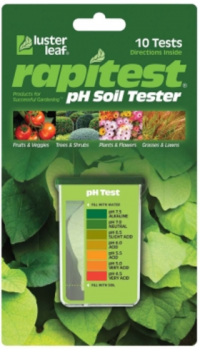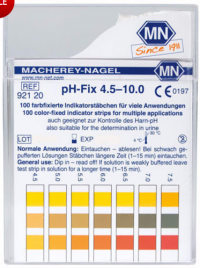
Soil pH measurement and amendment
klugesmith, Mon Jun 12 2017, 07:01PMOur Dawn Redwood tree (Metasequoia glyptostroboides) has outgrown its 1-gallon plastic pot. We aren't sure where it belongs in the ground, so it's about to move into a nominal 35-cm plastic pot. It's known as an acid-loving plant (pH 5.0 would not be too low), and soil dug up around here has measured pH around 7.0 or 7.5.
Who here is good with soil pH testing conventions? My kit from the hardware store comes with a clear plastic cuvette. You put in soil up to the line at about 1 cm^3. Is that packed or loose? Then you add some powder (entire contents of one gel cap), and water up to the line at about 5 cm^3. Mix, let the particulates settle, and read the color. Not sure if the powder has anything besides indicator dyes and inert filler.

I saved the juice after cooking some red cabbage (Oma called it Rotkohl) for dinner. Counted drops of vinegar and ammonia to toggle its color; then left the rest in fridge until mold grew on it.
Later, at the science store, I got a small bottle of Methyl Red and a pack of three-bar pH test strips. The color-matching card for ph 7 to 10 is on the other side of the box.

For those I've been using a glass test tube, with soil/water ratio similar to that in the Luster Leaf kit.
I know how the concentrations of H+ and OH- work (like electron and hole densities in solid silicon). But it's been many decades since I knew how to be quantitative about strong and weak acids, buffers, etc.
The amending of soil for agriculture has been studied since prehistoric times. It's been quantitative, in pH terms, since the 19th century. For acidification, some suggested additives are elemental sulfur, aluminum sulfate, and ammonium sulfate. Quantities are often expressed as equivalent weights of straight S. Which, apparently, slowly changes to sulfate through microbial action.
To avoid having to wait, or to pick a cation, I have used sulfuric acid. For example: 15 ml of drain opening fluid in 200 to 400 ml of water, used to dampen 2 coffee cans full of coarsely sifted soil, is not quite enough. Anybody got practical wisdom to offer here?
Thanks!
Re: Soil pH measurement and amendment
2Spoons, Tue Jun 13 2017, 12:38AM
Peat and fresh compost can be quite acidic. I'd use one or both of those as the basis for an acid loving container plant. Ongoing breakdown of organic matter produces humic acid, which will help maintain pH. Mineral additives like sulfuric acid get washed out of a pot fairly quickly.
2Spoons, Tue Jun 13 2017, 12:38AM
Peat and fresh compost can be quite acidic. I'd use one or both of those as the basis for an acid loving container plant. Ongoing breakdown of organic matter produces humic acid, which will help maintain pH. Mineral additives like sulfuric acid get washed out of a pot fairly quickly.
Re: Soil pH measurement and amendment
johnf, Tue Jun 13 2017, 06:58PM
usually soil from under pine trees is very acidic
johnf, Tue Jun 13 2017, 06:58PM
usually soil from under pine trees is very acidic
Re: Soil pH measurement and amendment
rikkitikkitavi, Mon Aug 28 2017, 05:28AM
I wouldnt recommend using mineral acids etc. They wash put immediatemy, give a pH shock and will deplete the buffer capacity of the soil.
Use peat or similar soil improvers. I used that for my blueberry plants even if I spread limestone on my lawn just next to it to raise pH.
rikkitikkitavi, Mon Aug 28 2017, 05:28AM
I wouldnt recommend using mineral acids etc. They wash put immediatemy, give a pH shock and will deplete the buffer capacity of the soil.
Use peat or similar soil improvers. I used that for my blueberry plants even if I spread limestone on my lawn just next to it to raise pH.
Print this page